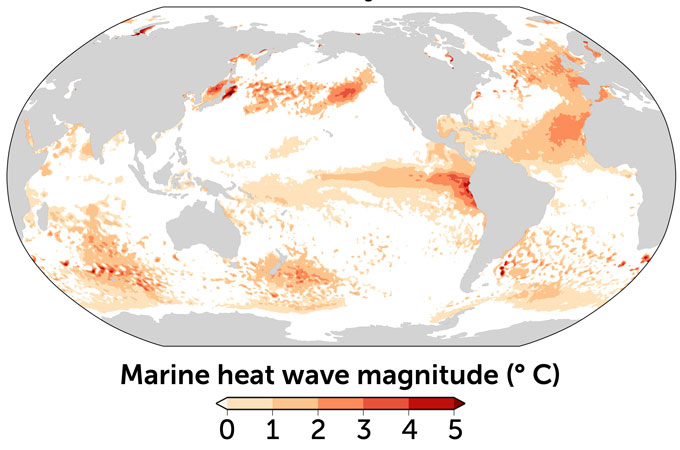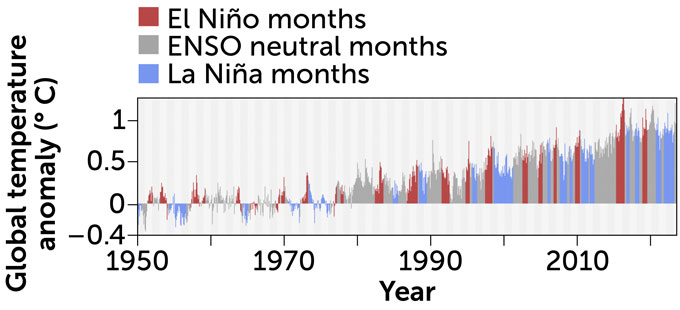Hot Oceans and the Return of El Niño Set the Stage for Unprecedented Heatwaves

Uncharted Territory: Record-Breaking Global Temperatures Blamed on El Niño and Climate Change
In a blistering turn of events, the Earth is grappling with soaring temperatures that are rewriting the record books. Recent data from the U.S. National Centers for Environmental Prediction has confirmed that July 3 witnessed the highest average global temperature ever recorded, standing at a scorching 17.01°C (62.62°F), surpassing the previous record set in August 2016. Astonishingly, this record was shattered or equaled three more times by the end of the week, peaking at a sweltering 17.23°C (63.01°F) on July 6. As if that wasn’t enough, June was also crowned as the hottest June ever recorded.
This unprecedented heatwave can be attributed to a confluence of factors, including the alarming state of our oceans and the resurgence of the notorious climate pattern, El Niño. Climate scientists assert that our planet’s seas have been steadily warming for decades, with the most recent decade experiencing the highest sea surface temperatures since the 1800s. In April, the world’s oceans reached a staggering average surface temperature of 21.1°C, marking an all-time high. Notably, the North Atlantic and the Gulf of Mexico have been hit particularly hard by these rising temperatures, with marine heat waves wreaking havoc in these regions.
These marine heat waves, characterized by persistently elevated ocean temperatures, currently plague around 40 percent of the world’s oceans. Alarming forecasts from the U.S. National Oceanic and Atmospheric Administration (NOAA) suggest that by September, these heat waves could engulf half of the global ocean. The frequency of such extreme events has surged by approximately 50 percent over the last decade, largely due to human-caused climate change. The repercussions of hotter seas extend far beyond their immediate impact on marine life. Atmospheric scientist Marybeth Arcodia of Colorado State University warns that the ocean is currently absorbing about 93 percent of the heat associated with global warming. As the oceans warm, their capacity to absorb heat diminishes, resulting in an accumulation of heat in the atmosphere and a subsequent rise in global temperatures.
Marine heat waves, prolonged periods of abnormally high ocean temperatures, have emerged as a pressing concern, enveloping approximately 40 percent of the world’s oceans. The extent and intensity of these heat waves can be visualized through a map showcasing average sea surface temperature anomalies from June 13 to July 12, 2023. Darker shades of red on the map indicate more intense temperature anomalies, highlighting the severity of the situation.

Compounding the heat crisis is the return of El Niño, a natural climate cycle known as the El Niño-Southern Oscillation (ENSO). This phenomenon entails fluctuations in sea surface temperatures in the central and eastern tropical Pacific Ocean, governed by equatorial air currents called the trade winds. During El Niño, warm water in the western Pacific surges back toward the Americas, disrupting the oceanic upwelling along the South American coast and leading to the heating of the tropical Pacific. The resultant heat is then released into the atmosphere, exacerbating global warming. Conversely, La Niña, the counterpart of El Niño, is often associated with cooler global temperatures.
However, the relationship between El Niño, La Niña, and global temperatures is not always predictable. For instance, 2020, the second hottest year on record, occurred during La Niña conditions, highlighting the influence of climate warming on these record-breaking temperatures. While scientists agree that El Niño is contributing to the current heatwave, accurately quantifying its exact impact is challenging.
The current El Niño is still in its early stages and is expected to peak during the Northern Hemisphere’s winter. Therefore, the full force of its impact on global temperatures is yet to be felt. Climate scientists caution that even higher global temperatures are likely in the coming months, with predictions indicating a better than 50 percent chance of this El Niño becoming a relatively strong one. If this scenario unfolds, the average temperature of the east-central tropical Pacific could temporarily surpass or reach 1.5°C above normal. With the potential for 2023 to become the hottest year on record, concerns are mounting that global warming could exceed the critical 1.5°C threshold, triggering irreversible changes in vulnerable ecosystems such as the Amazon rainforest and the ice sheets of Greenland and Antarctica.
 As the world finds itself caught in this monumental experiment, the stakes for life on Earth have never been higher. The combined forces of El Niño and climate change have propelled us into uncharted territory, demanding urgent action to mitigate the escalating effects of our warming planet. With hotter oceans and an unpredictable climate pattern, the need for comprehensive and effective measures to address climate change has become more pressing than ever before.
As the world finds itself caught in this monumental experiment, the stakes for life on Earth have never been higher. The combined forces of El Niño and climate change have propelled us into uncharted territory, demanding urgent action to mitigate the escalating effects of our warming planet. With hotter oceans and an unpredictable climate pattern, the need for comprehensive and effective measures to address climate change has become more pressing than ever before.




